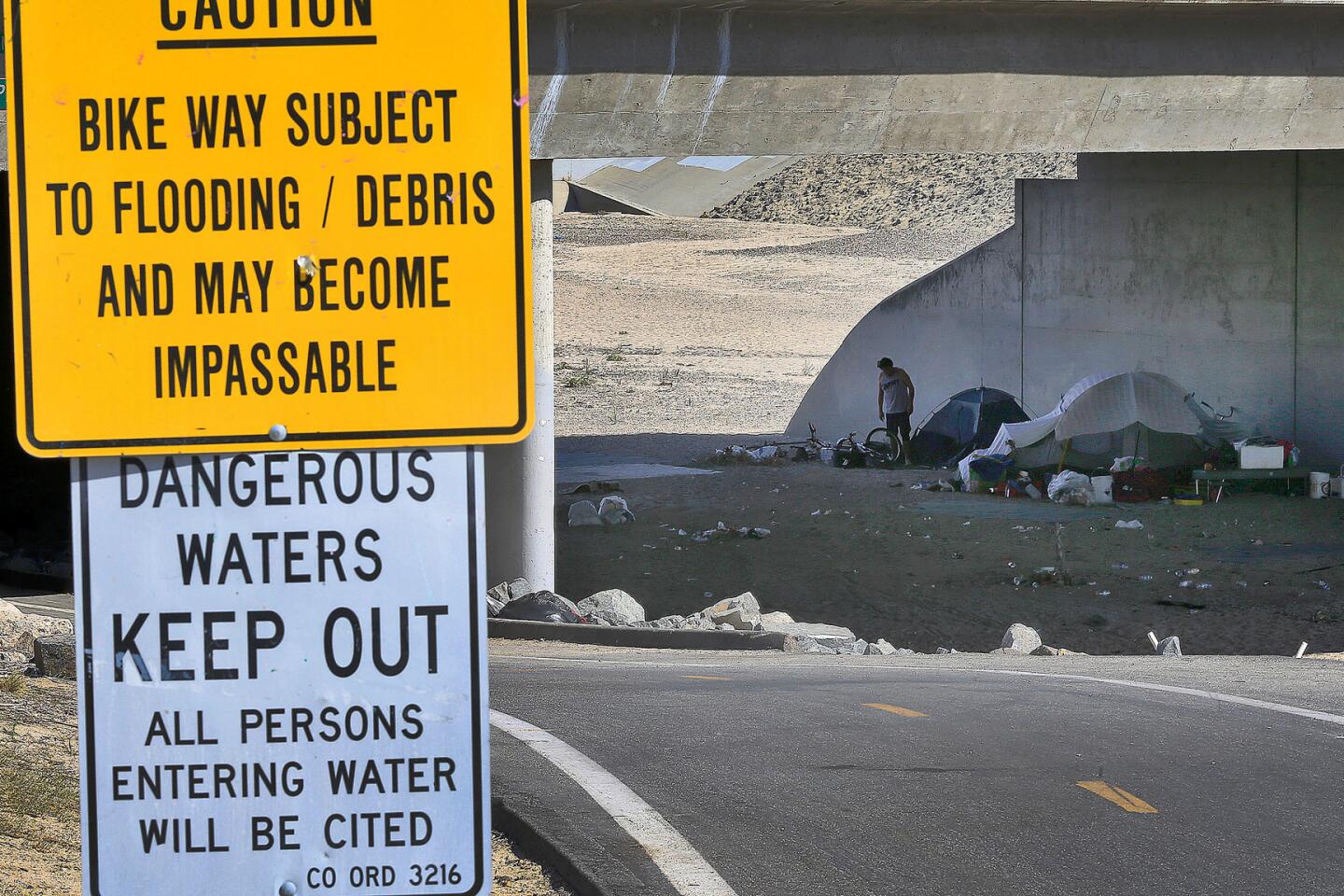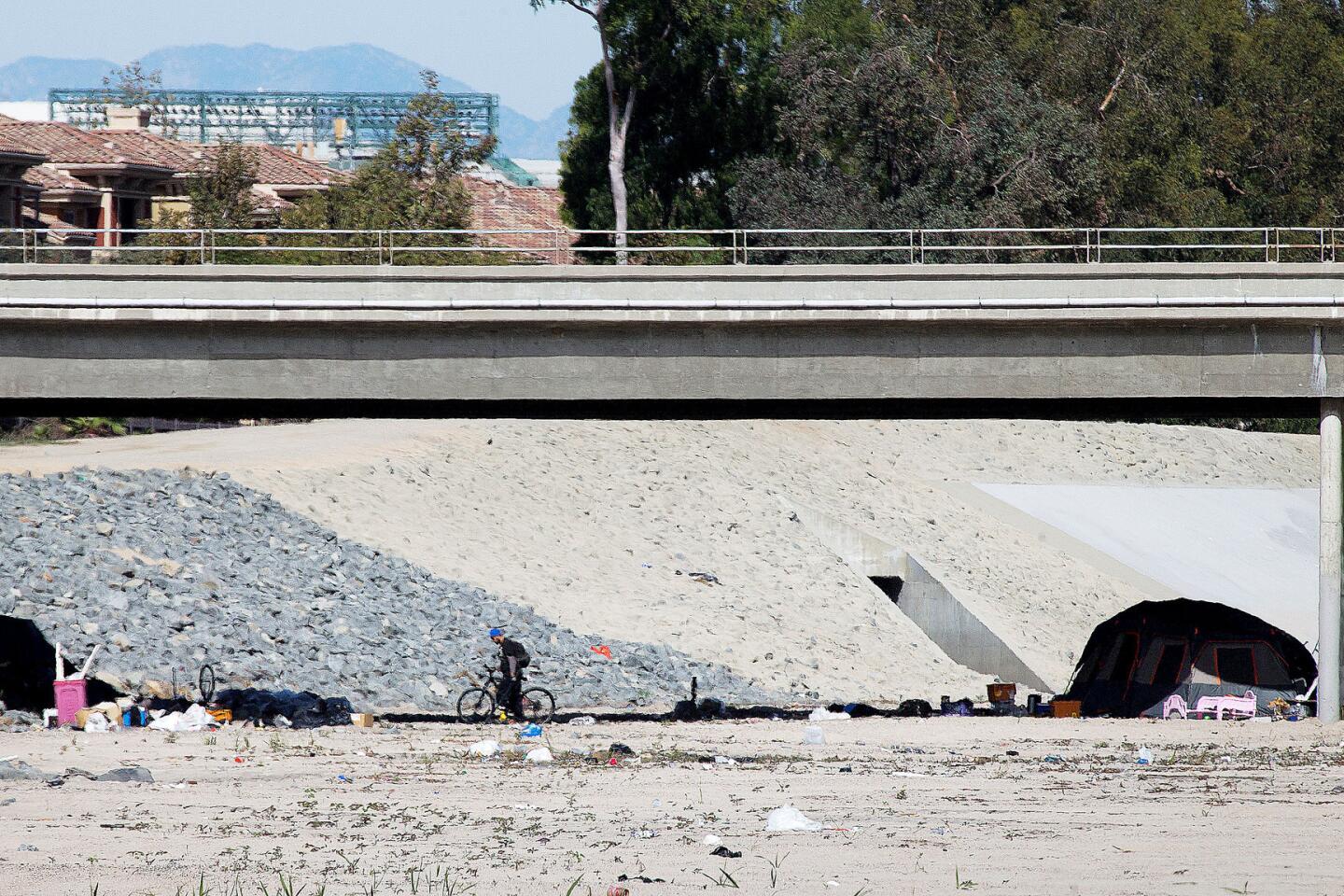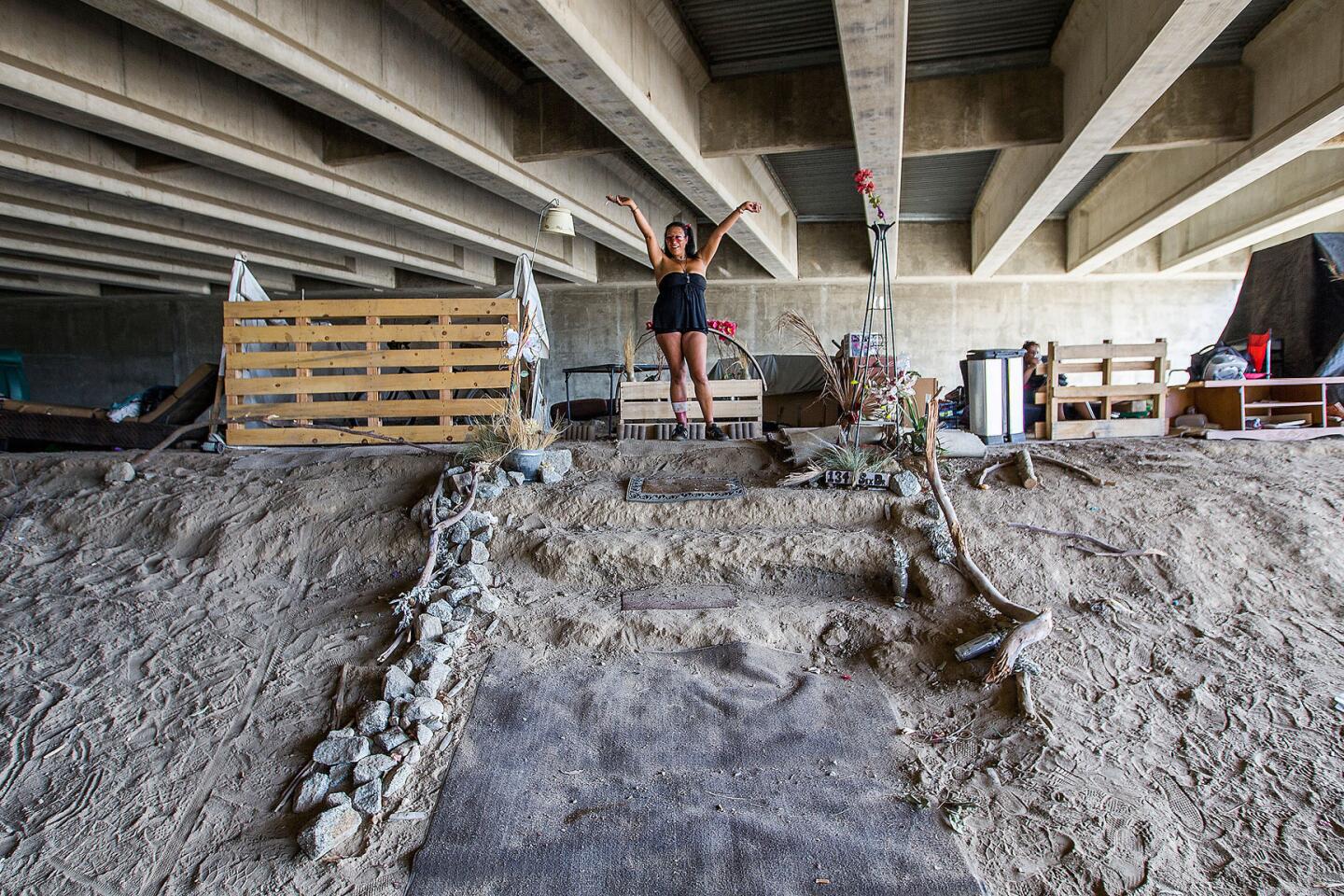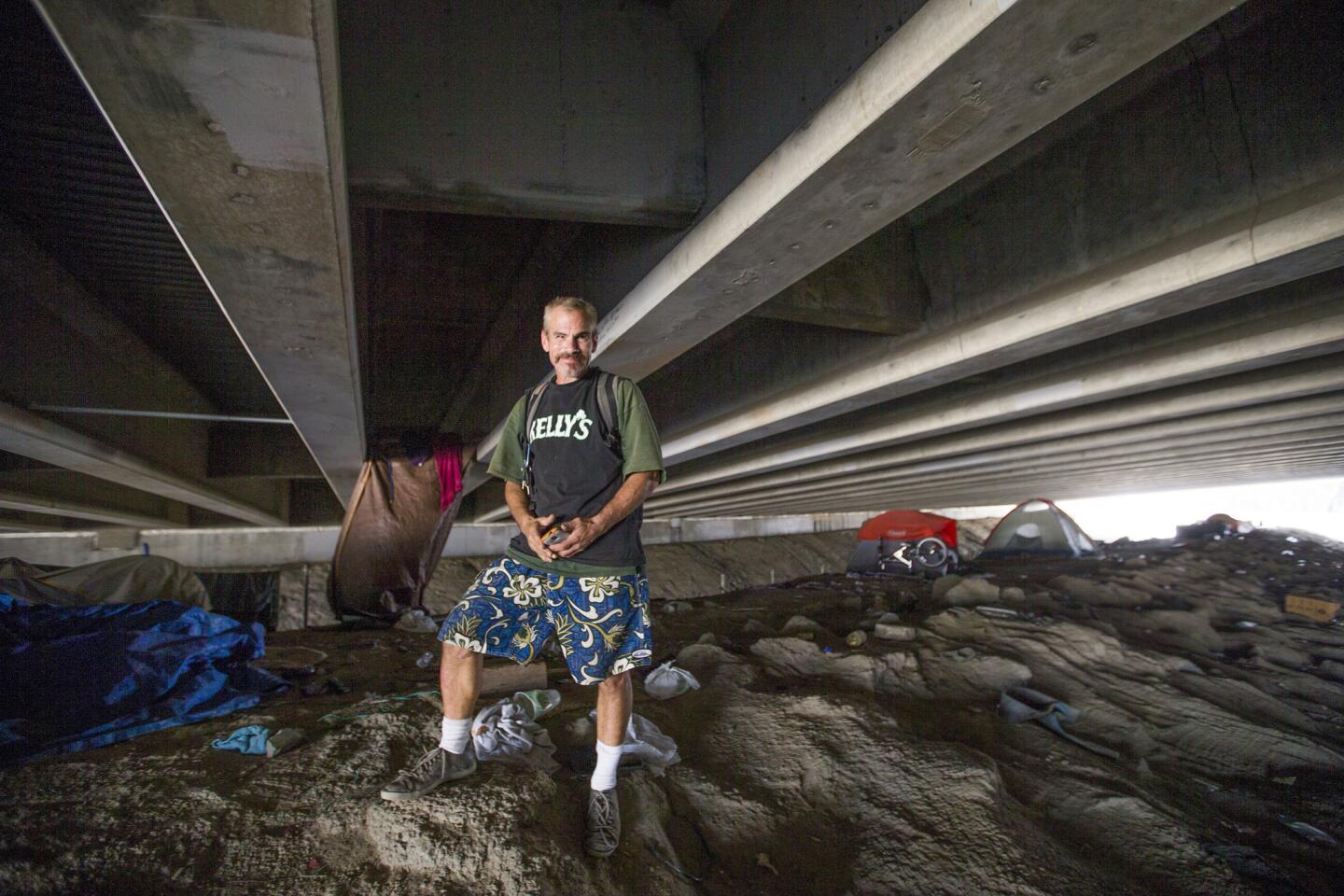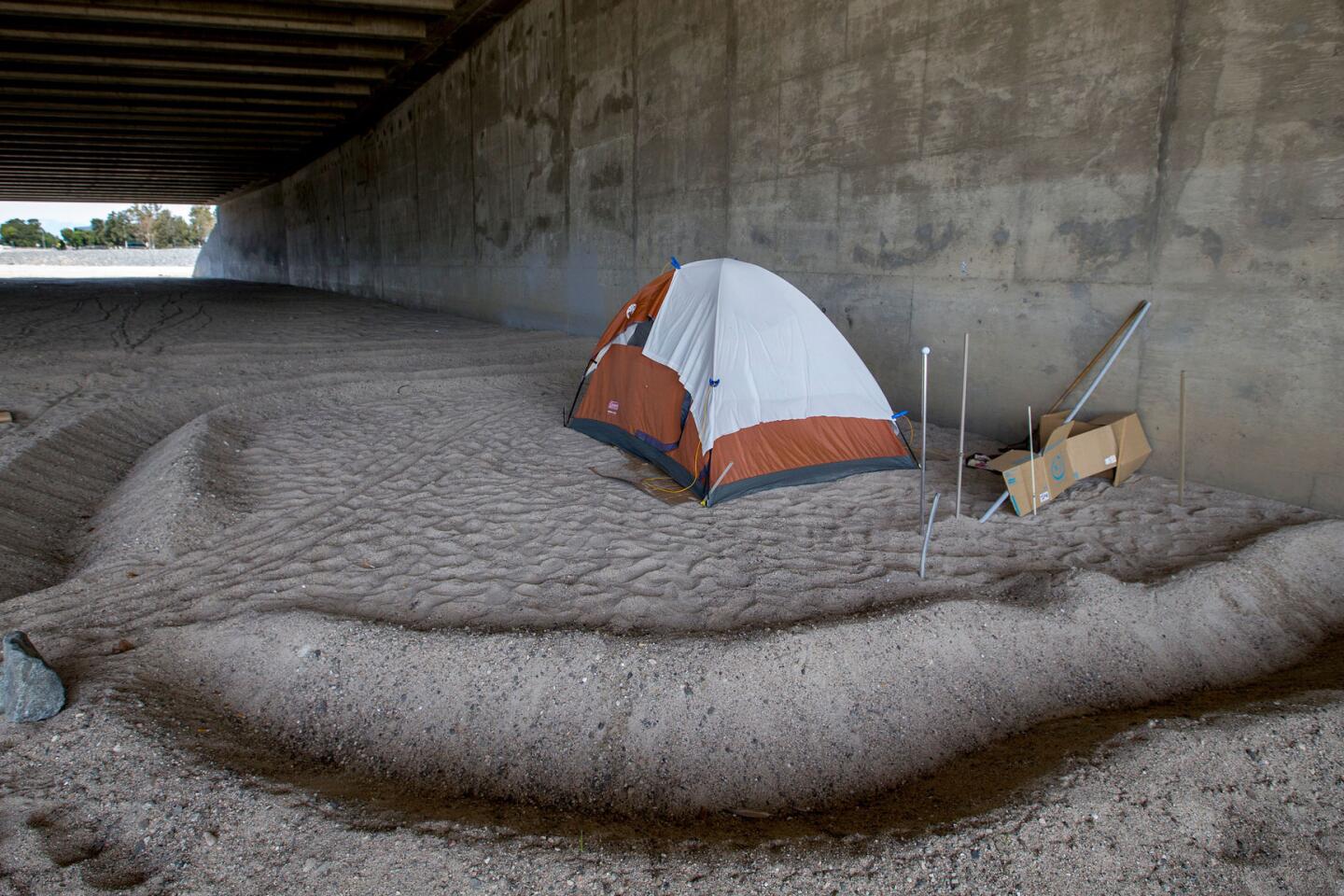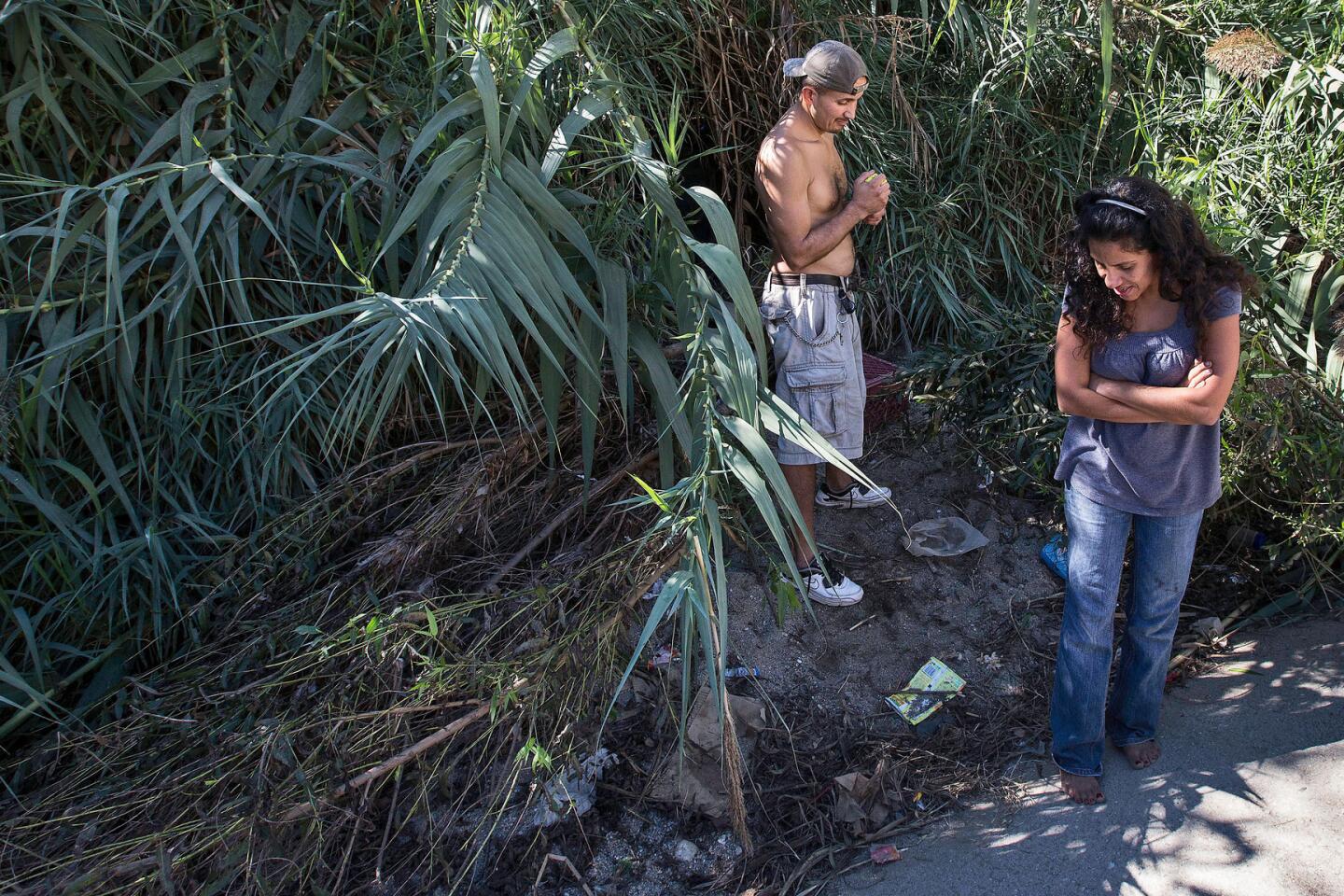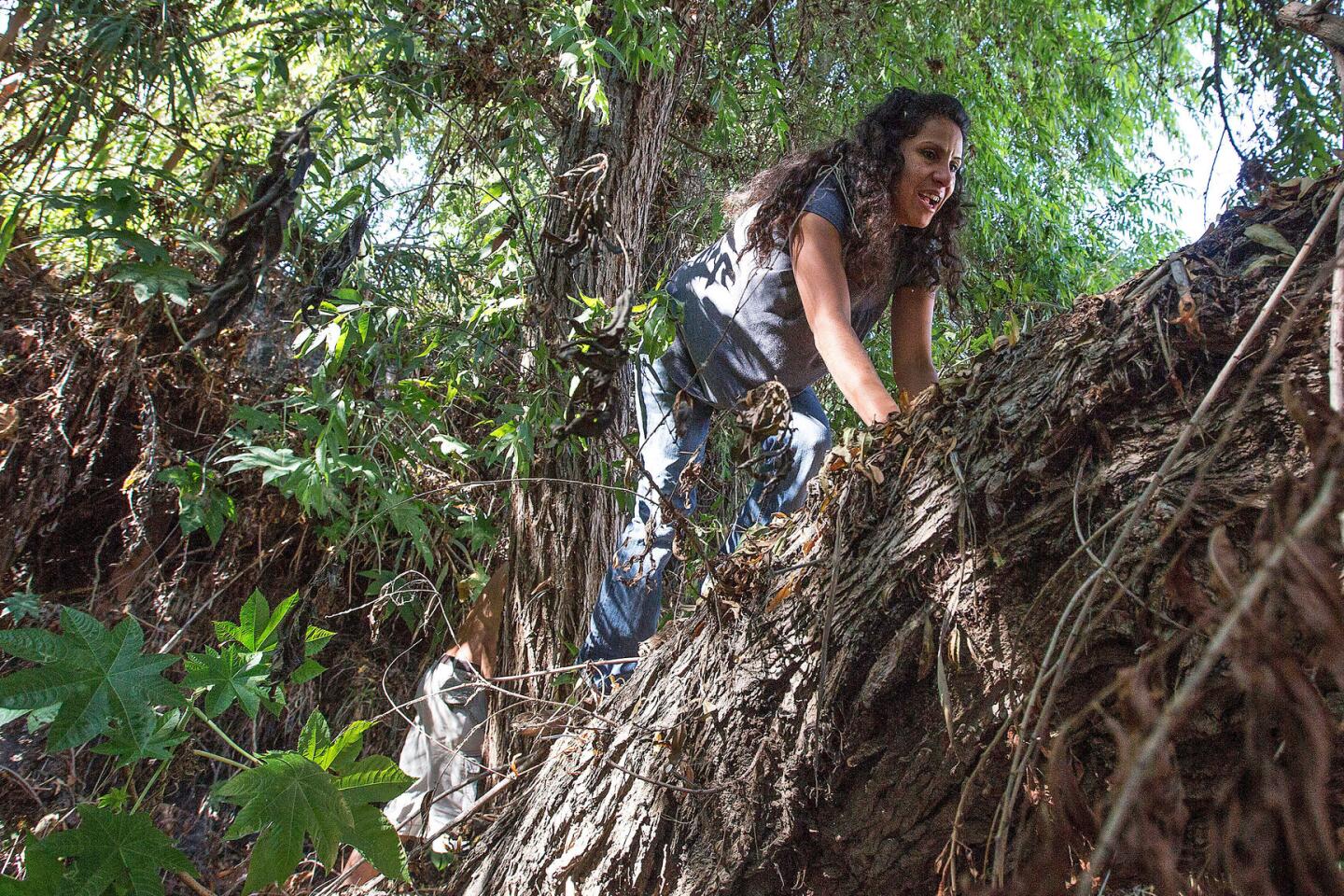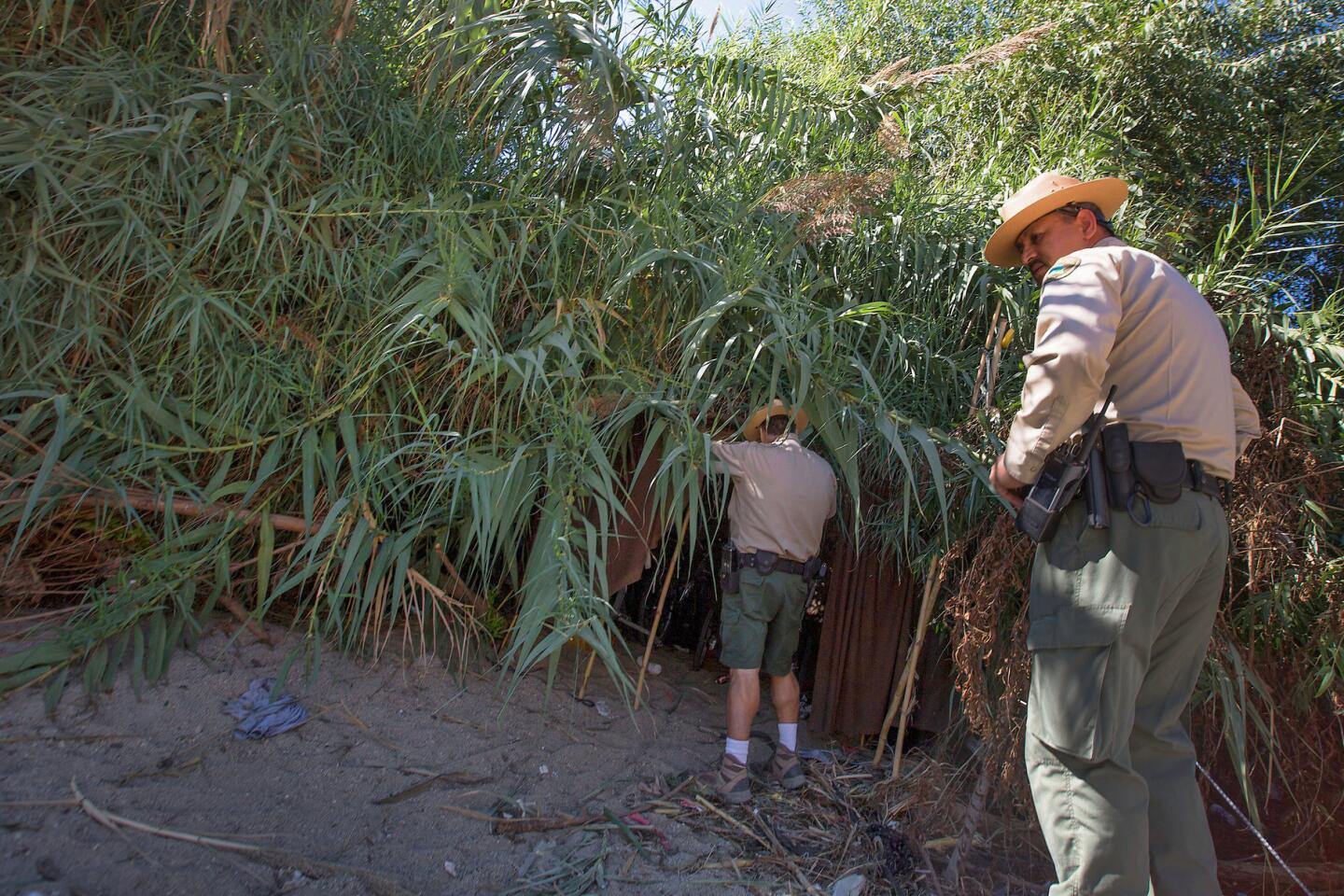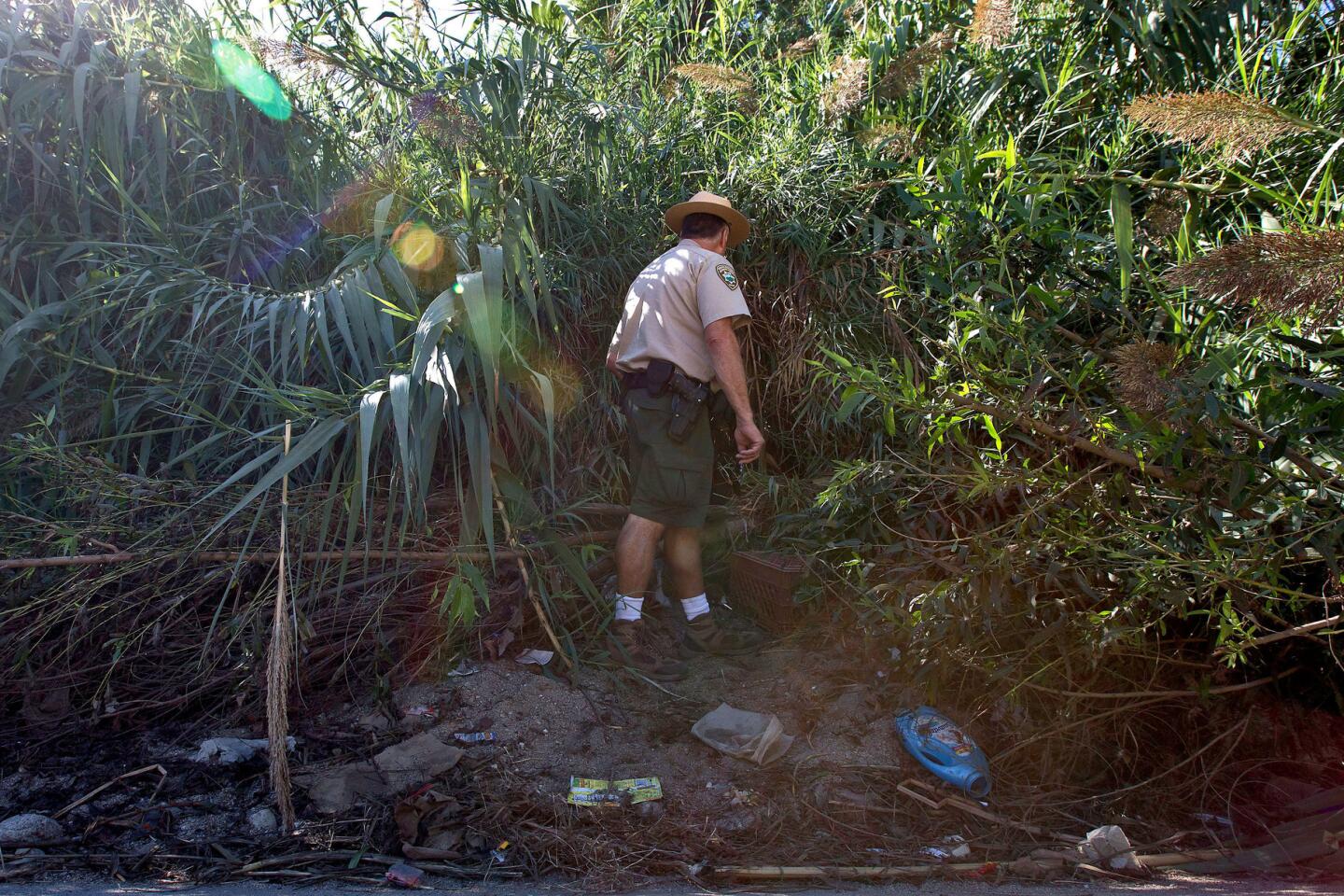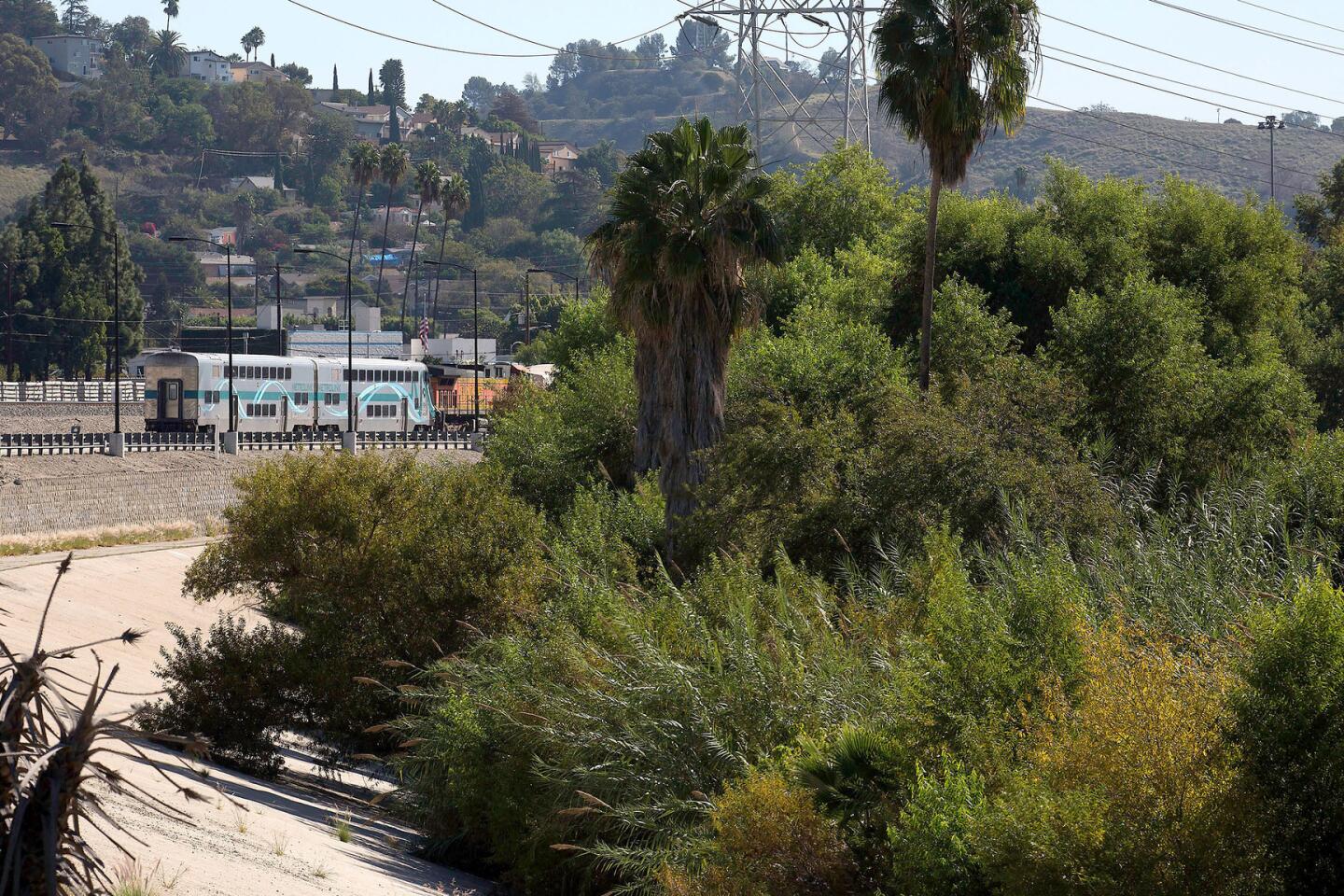Hundreds of homeless riverbed dwellers at risk of drowning from El Niño flooding, experts say

- Share via
The nine homeless men living inside a concrete storm drain in Orange County believe they are ready for the floods likely to come raging through if El Niño brings the deluges forecasted to arrive about a month from now.
“I ain’t afraid of El Niño — I think I can whip it!” said Bill “Tattoo” LeBlanc, 74, who has lived in the tunnel for 20 years.
LeBlanc and his homeless friends are among hundreds of people living in or near storm channels across Southern California who believe they can handle whatever nature throws at them this winter.
Storm experts said LeBlanc and the others are dangerously wrong. Lulled into a false security by years of drought and mild winters, many of those homeless people will drown if they don’t move before the rains come, they said.
To avert fatalities, authorities from myriad public agencies are trying to persuade river people to seek safer places to live. If those efforts fail, authorities say, they will try to forcibly remove them if flooding is imminent.
The storm drain in Orange County is a case in point. It is less than half a mile from Angel Stadium of Anaheim and it empties onto a Santa Ana River bank under an overpass on the 5 Freeway.
LeBlanc and his companions use flashlights and candles to see in the darkness and sleep on plywood boards perched about four feet above algae-covered water, which quickly transforms into a debris flow during heavy rains.
If it floods in there, all you got to do is lay on your back and float out the tunnel feet first so you don’t hit your head on a concrete wall.
— Bill “Tattoo” LeBlanc
“If it floods in there, all you got to do is lay on your back and float out the tunnel feet first so you don’t hit your head on a concrete wall,” LeBlanc said recently. “Also, keep your eyes shut tight because the water is really nasty. I’ve had to do that twice,” he said with a laugh.
A dozen homeless men and women in a nearby encampment in the river bed recently dug water diversion trenches in the sand around their tents to prepare for the rains.
“The water is our No. 1 enemy, so these trenches will buy us a little time in a flood,” said Ari Palomo, 51.
The trenches are about 18 inches deep — and will do nothing if water fills the channel, which is more than three times as tall as Palomo.
“We’re also thinking about attaching large empty water containers to our tents so that they’ll float,” Palomo said.
That kind of talk frustrates social service specialists and emergency response officials as the prospect of El Niño-fueled storms looms over the Los Angeles, San Gabriel and Santa Ana rivers and their drainages.
Keeping the homeless out of rivers, creeks and flood control channels is all but impossible because they are guarded only by chain-link fences, guardrails and occasional security patrols.
Law enforcement effectiveness in the watershed has always been muddled by a confusing overlap of jurisdictions among city, county, state and federal agencies, including the U.S. Army Corps of Engineers.
Signs have been posted warning people to keep out of rivers and flood-control channels during the storm season that began in October and ends in March. River dwellers use those signs as grips to pull themselves up onto makeshift beds in the trash-strewn alcoves of bridges and overpasses.
In Los Angeles County, a task force is addressing the risks facing homeless encampments along 172 miles of waterways deemed especially vulnerable to flooding: the San Gabriel and Los Angeles rivers, the Rio Hondo, Big Tujunga Wash and the Arroyo Seco.
A recent aerial survey of those areas counted roughly 500 individuals living in them, said L.A. County Sheriff’s Capt. Jeffrey Perry. The actual number may be far higher because many encampments are hidden by vegetation and bridges, and used by highly transient populations, he said.
“Making arrests, most likely on trespassing charges, would be used only as a last resort in emergency situations,” said Sheriff’s Lt. John Voza. “Most people comply with our requests that they move along before such laws are enforced.”
Bernadette Fierro, 45, and David Quinones, 40, who have spent nearly four years in a Los Angeles River camp camouflaged by dense groves of arundo, are determined to stay put.
On Sept. 15, Quinones and his pit bull were pulled to safety by swift-water rescue teams after record-breaking rainfall transformed the usually placid stretch just north of downtown into a raging torrent filled with flotsam, boulders and uprooted trees.
Since then, the couple have nailed boards and sticks onto the trunk of a cottonwood tree to make a ladder and “hand rails” roughly six feet above the river bottom.
On a recent weekday, they demonstrated their safety system for visitors, including two Mountains Recreation and Conservation rangers, Fernando Gomez and David Aceves.
“If we get flooded we’ll run to this tree as fast as we can, then climb up the ladder, grab hold of the hand rails and wait it out,” Fierro said.
Gomez, who has helped haul 15 people out of the Los Angeles River over the past 10 years, nodded toward the makeshift ladder.
“Interesting,” he said. “But here’s our plan. Even before it rains, we’re going to send people out here to say, ‘Hey folks, it’s time to move out of the river bed.’ ”
“And by the way,” he added, hastily taking out a notebook and pen, “just in case, what are your names and cellphone numbers?”
ALSO
L.A. lawmakers’ shortcut backfired for animal rescue shops
Airbnb’s call for potential hosts turns up a wide range of takers
Rescuers cut fishing line wrapped around whale’s tail off La Jolla coast
More to Read
Sign up for Essential California
The most important California stories and recommendations in your inbox every morning.
You may occasionally receive promotional content from the Los Angeles Times.
